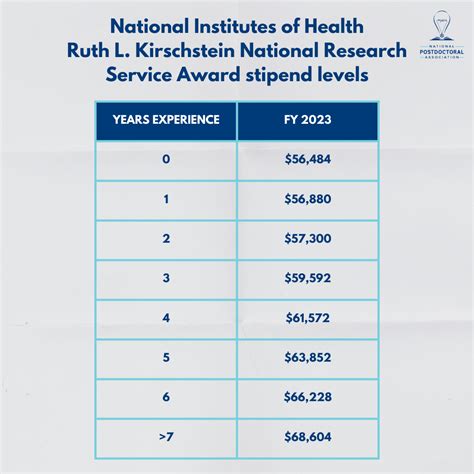Embarking on a postdoctoral fellowship funded by the National Institutes of Health (NIH) is a prestigious and critical step in the career of a research scientist. It's a period of intense intellectual growth, discovery, and mentorship. But as you transition from graduate student to professional researcher, a crucial question arises: What can you expect to earn?
An NIH-funded postdoctoral position offers a structured and nationally recognized salary, with current stipends for new postdocs starting at over $61,000 annually. This guide will break down the official NIH salary structure, explore the key factors that influence your earning potential, and provide insight into the career outlook for this vital profession.
What Does an NIH-Funded Postdoctoral Fellow Do?

A postdoctoral fellowship, often called a "postdoc," is a temporary, mentored research position that allows individuals with a doctoral degree (Ph.D., M.D., D.V.M., etc.) to gain additional specialized training. Think of it as an apprenticeship for a senior scientist. Whether you're working directly at an NIH campus (intramural) or at a university with an NIH grant (extramural), your core responsibilities will revolve around advancing a research project.
Key responsibilities include:
- Designing and conducting experiments to test scientific hypotheses.
- Collecting, analyzing, and interpreting complex data.
- Writing and publishing findings in peer-reviewed scientific journals.
- Presenting research at national and international conferences.
- Applying for grants and fellowships to secure future funding.
- Mentoring junior lab members, such as graduate and undergraduate students.
Ultimately, a postdoc is about developing the skills, publication record, and professional network needed to become an independent investigator, whether in academia, government, or industry.
Average Postdoctoral NIH Salary

The most definitive source for NIH postdoctoral salaries is the NIH itself. The NIH sets the baseline salary levels for its Kirschstein National Research Service Award (NRSA) recipients. These stipends are the benchmark used by most institutions for postdocs funded by NIH grants.
For Fiscal Year 2024, the NIH announced the following stipend levels, which are tied directly to years of postdoctoral experience:
| Years of Experience | FY2024 Stipend | Monthly Stipend |
| :--- | :--- | :--- |
| 0 | $61,008 | $5,084 |
| 1 | $61,452 | $5,121 |
| 2 | $61,908 | $5,159 |
| 3 | $64,308 | $5,359 |
| 4 | $66,288 | $5,524 |
| 5 | $68,604 | $5,717 |
| 6 | $71,004 | $5,917 |
| 7 or more | $73,380 | $6,115 |
Source: NIH Notice NOT-OD-24-104, Released April 16, 2024.
It's important to note that this scale represents the *minimum* stipend level. Many institutions, especially those in high-cost-of-living areas, provide supplements to make their offers more competitive.
For broader context, salary aggregators show a wider range for postdoctoral fellows across all funding sources (including industry). For instance:
- Salary.com reports the average Postdoctoral Research Fellow salary in the United States is around $62,176, with a typical range falling between $56,419 and $69,384.
- Glassdoor places the total estimated pay for a Postdoctoral Fellow at approximately $69,825 per year, which includes an average base salary of $61,164 plus additional pay like bonuses or profit-sharing.
These figures align closely with the official NIH scale, reinforcing its role as the national standard for academic and government postdoctoral positions.
Key Factors That Influence Salary

While the NIH provides a clear framework, several factors can influence your final compensation package.
###
Years of Experience
As demonstrated in the table above, this is the single most important factor determining your base NIH stipend. The NIH formally recognizes the value of continued training by mandating a salary increase with each year of postdoctoral experience. When you apply for a position or an NIH fellowship (like an F32), your years of prior postdoctoral experience are used to set your starting stipend level.
###
Geographic Location
The NRSA stipend scale is the same nationwide, regardless of location. However, the cost of living varies dramatically across the United States. A $61,008 salary provides a very different lifestyle in Houston, Texas, compared to Boston, Massachusetts, or San Francisco, California.
To remain competitive and attract top talent, universities and research institutes in high-cost-of-living areas often supplement the NIH stipend with institutional funds. If you are considering positions in cities like San Diego, New York, Seattle, or Washington D.C., it's common to see total salaries that are 10-20% higher than the NRSA base level.
###
Institution Type
Where you do your postdoc plays a significant role in your potential earnings and the type of pay scale you are on.
- University (Extramural): This is the most common path. You work at a university or private research institute, and your salary is paid from an NIH grant awarded to the institution or directly to you. Your salary will be at or above the NRSA minimums.
- Government (Intramural): If you work directly for the NIH on its campuses in Bethesda, Maryland, or other locations, you are an Intramural Research Training Award (IRTA) or Cancer Research Training Award (CRTA) fellow. Your salary is set by a different scale—the Title 42 pay model or General Schedule (GS)—which is often higher than the NRSA scale to account for the higher cost of living in the D.C. area.
- Private Industry: A postdoctoral position at a pharmaceutical or biotechnology company will almost always pay significantly more than an academic one. Industry postdocs can earn salaries ranging from $75,000 to over $100,000, as companies compete for talent and value research that is closer to commercial application.
###
Area of Specialization
While the NIH stipend is field-agnostic, your area of specialization can impact your ability to secure a higher, supplemented salary. Fields with high demand in the lucrative biotechnology and pharmaceutical industries often command higher pay, even in academia.
Specializations like computational biology, bioinformatics, immunology, cancer biology, and neuroscience are highly sought after. Principal Investigators with large grants in these areas may have more discretionary funds to supplement postdoc salaries to attract the best candidates.
###
Level of Education
For a postdoctoral position, a terminal degree is a prerequisite, not a variable. You are expected to have a Ph.D., M.D., or equivalent doctoral degree. This level of education is the entry ticket to the role, and the salary scales are designed specifically for individuals who have already achieved this advanced academic milestone.
Job Outlook

A postdoctoral fellowship is a training position, a bridge to a permanent career. The career outlook for the scientists these fellowships produce is strong. The U.S. Bureau of Labor Statistics (BLS) projects that employment for Medical Scientists is expected to grow 10% from 2022 to 2032, much faster than the average for all occupations.
The BLS cites growth in medical research at pharmaceutical companies and universities, particularly in areas like cancer treatment and Alzheimer's disease, as a key driver of this demand. An NIH-funded postdoc provides the exact training and credentials needed to be a competitive candidate for these roles. The median pay for Medical Scientists in May 2023 was $100,770 per year, highlighting the strong earning potential after completing a fellowship.
Conclusion

Choosing an NIH-funded postdoctoral fellowship is an investment in your future as a scientist. While not as lucrative as an immediate jump to industry, it offers unparalleled training, mentorship, and a clear path toward a rewarding career.
Key Takeaways:
- Standardized & Transparent Salary: Your base salary is determined by the official NIH NRSA stipend scale, which starts at $61,008 for new postdocs in 2024.
- Experience is Rewarded: Your salary directly increases with each year of postdoctoral experience.
- Context Matters: Your total compensation can be higher depending on your location, institution, and the competitiveness of your research field.
- A Strong Career Foundation: The skills, publications, and network you build as a postdoc are a launchpad for a high-demand, high-impact career as a scientist, with significant long-term earning potential.
For any aspiring researcher, an NIH postdoc represents a golden opportunity to contribute to human health while building the foundation for a successful and fulfilling scientific career.
